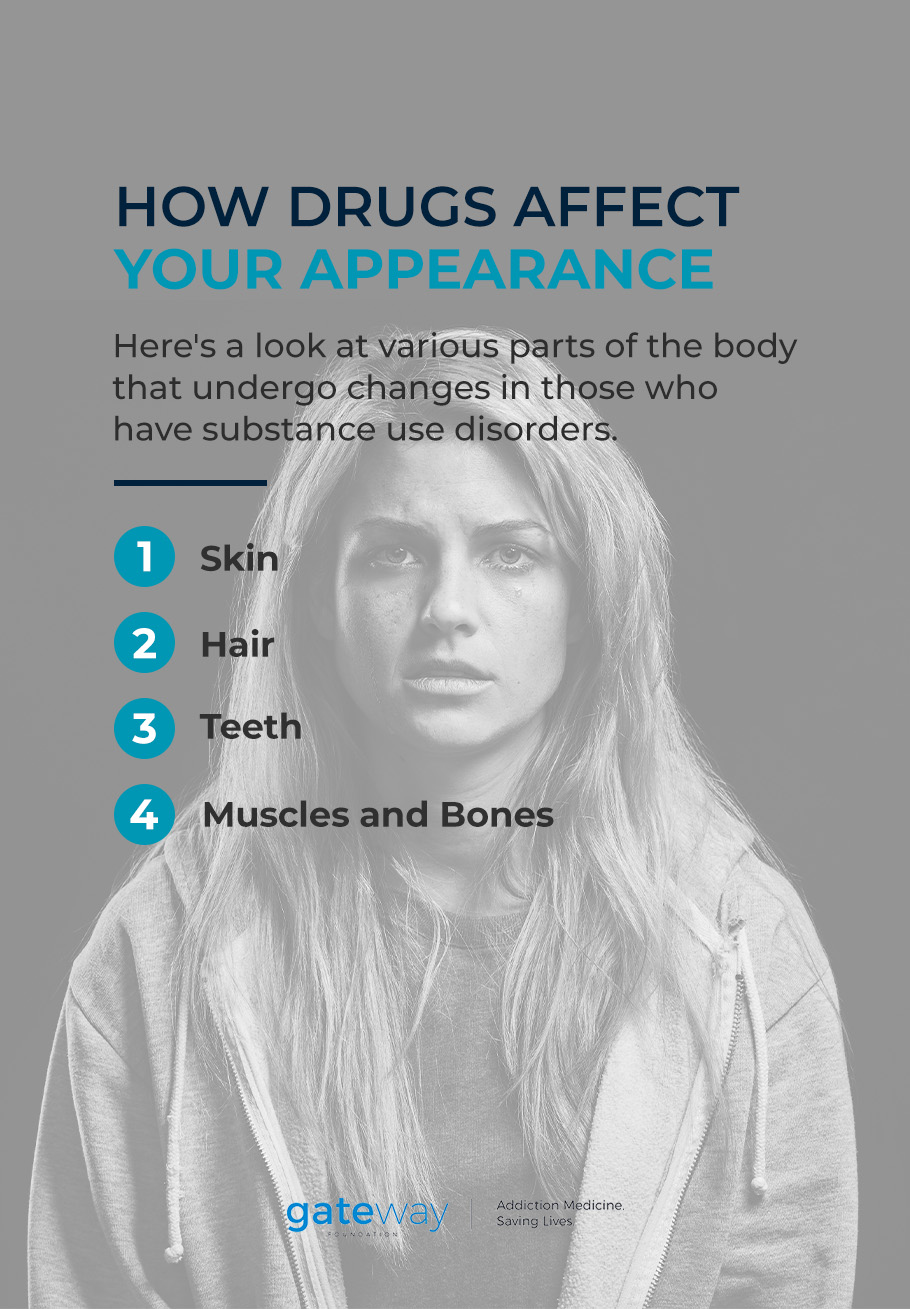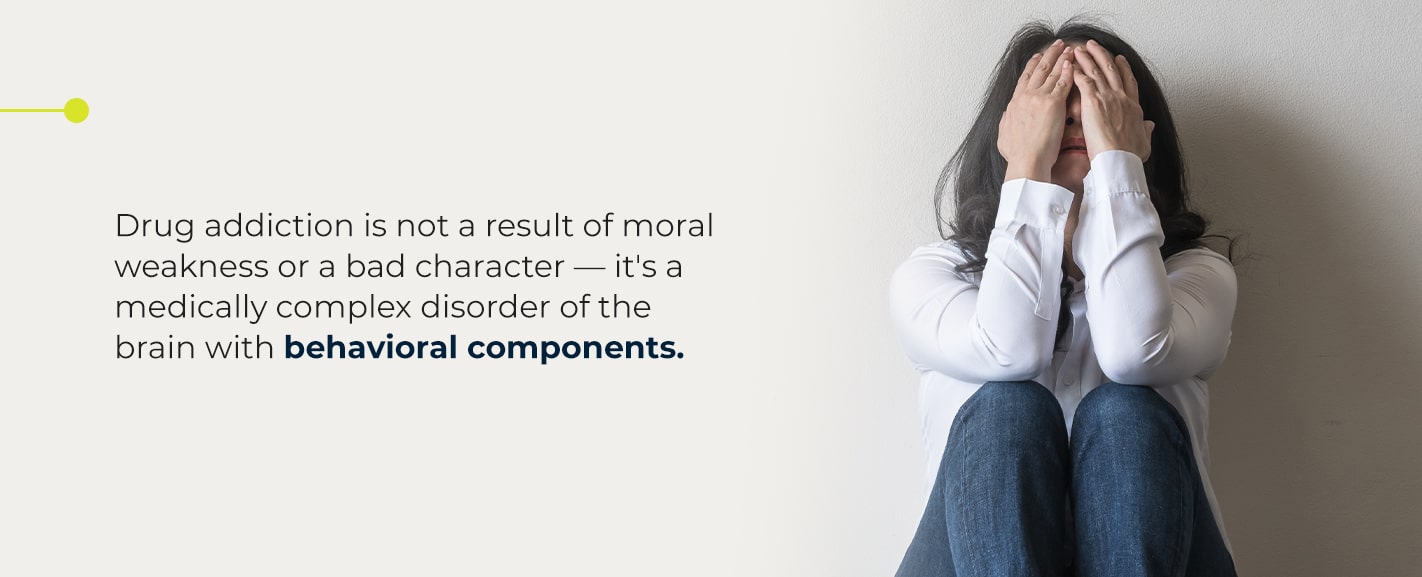- Nov 15
- Drug Addiction Treatment
Many people know substance use disorders have adverse medical and psychological side effects. However, substance use can also influence your physical appearance — and that’s what other people notice first. Because illicit drug use has an impact on the brain and body, your physical appearance can show the impacts over time.
From your teeth to your bones, substance use causes numerous outward issues. These concerns can have an impact on your personal and professional life. Unfortunately, individuals often associate shame or embarrassment with their new physical appearances, so they avoid help at all costs.
Thankfully, you can pursue various treatment options to assist your situation.
- How Drugs Affect Your Appearance
- Stigmas About Appearance and Substance Use
- Can You Get Your Looks Back After Substance Use?
- Contact Gateway Foundation to Start Your Recovery Journey
How Drugs Affect Your Appearance
Drugs affect your appearance in both subtle and drastic ways through changes to the skin, hair, teeth, muscles and bones. If you struggle with a substance use disorder, you may notice your appearance alters over time but not understand why. Drugs cause ongoing and complex issues to both your body and appearance and, in addition to affecting your health, can significantly impact your self-esteem.
Here’s a look at various parts of the body that undergo changes in those who have substance use disorders.
1. Skin
People often ask, do drugs cause acne or do drugs cause wrinkles? While the answer to these questions is yes, the effects of substance use on the skin are more complex than just acne and wrinkles. As the largest organ of the body, the skin sometimes shows physical signs of deeper health concerns.
An increase in acne for individuals who struggle with substance use disorders may come down to simply the increased need to touch their face. Clogged or blocked pores on the face allow bacteria to grow, causing acne. In addition to face touching, acne occurs in those with substance use disorders because some drugs lead to increased sweat production. That sweat contains harmful toxins from the drugs that promote bacterial growth and acne if left to sit on the body.
Do drugs make you age faster? Drugs don’t speed up the aging process internally, but they can make you appear older. Wrinkles and dark spots caused by substance use can contribute to individuals appearing to be older. The most common cause of wrinkles is persistent exhaustion and lack of sleep. Those who use illegal drugs or misuse prescription medication can be up for days or even weeks at a time, taking an enormous toll on their health and their skin.
Certain illegal drugs have a reputation for damaging and destroying the skin. Methamphetamine is perhaps the most notorious of these drugs for the varied and severe skin issues it causes. Someone with a methamphetamine addiction may scratch and pick at their skin due to formication, a tactile hallucination of bugs or parasites crawling under the skin. Heroin, an opioid, can cause intense itching and even deadly skin abscesses when the use of unsanitary needles infects the skin. Necrosis, or skin cell death, appears from heroin, cocaine and methamphetamine use.
Other general skin issues that accompany substance use disorders include:
- Slow-healing wounds
- Dark spots
- Rashes
- Uneven skin tone
- Dry skin
- Chapped lips
- Scars from acne and lesions
Skin is often the first thing people notice about someone. It’s easy to feel self-conscious about the effects of substance use on your skin, and the scars it can leave behind. However, dermatologists agree that signs of aging and other skin issues can resolve for people in recovery. Therefore, those who seek treatment can likely look forward to reversing the effects of their substance use at least somewhat.
2. Hair
In addition to how drugs affect your face, substance use disorders can also impact and impede normal hair growth. Some drug testing uses hair samples because residual elements of illegal substances can collect and reside in the hair for a long time. Certain drugs can even alter and change the chemical and physical structure of the hair shaft, leading to weaker or damaged hair.
Most often, hair loss and decreases in hair health result from another symptom of substance use — stress. Stress can significantly impact the body and mind, leading some to scratch or pick at the scalp or pull their hair. While substance use disorder can lead to stress on the body, factors like failing or strained relationships, loss of work and struggles with recovery can also cause hair loss and a more general negative impact on the look and feel of the hair.
Drugs that cause stress-related hair loss include stimulants such as:
Stress is a significant factor in hair loss among those who struggle with drug use, but the actual substances themselves can also impact hair growth. Shock to the body, caused by the toxins in illicit drugs and heavy psychological stress from hallucinations, can also ‘shock’ the hair follicle. The medical term for this kind of acute drug-related hair loss is telogen effluvium, but it’s usually temporary. In most cases, the damage to the scalp is not so severe that it impacts hair growth for the rest of your life.
3. Teeth
Substance use also impacts the inside of your mouth. Similar to hair loss, dental issues from drug addiction can stem from both medical and psychological factors. Certain types of drugs induce extreme anxiety and stress. Many people with anxiety suffer from clenching, a condition in which they bite down so hard their jaw becomes sore and their teeth weaken. Substance use disorder often creates chronic anxiety, leading people to clench their teeth and possibly break a tooth from the constant pressure.
Different types of substances cause various dental problems:
- Alcohol: Alcohol use disorder can impact both tooth and gum health, and acidic beverages like wine can contribute to dental erosion.
- Stimulants: Methamphetamine and cocaine, among other stimulant drugs, can cause severe tooth decay, mouth sores, changes in smell and taste, and in the case of cocaine, perforations of the nasal septum and palate.
- Opiates: Heroin and morphine can lead to tooth loss and tooth decay in addition to reduced saliva production. Dry mouth, in turn, can lead to taste impairment, eating difficulties and gum disease.
- Cannabis: Cannabis use contributes to dry mouth, gum infections and even oral cancer.
- Hallucinogens: Ecstasy and LSD can lead to teeth grinding, dry mouth and oral tissue decay.
Stigma is also essential to discuss when considering the dental problems people with drug addiction face. For various reasons, such as lack of access, lack of insurance and fear of negative repercussions, those with substance use disorders may avoid seeking treatment for minor dental issues, creating more severe conditions later on.
4. Muscles and Bones
The musculoskeletal system includes muscle, bone, tendons and joints. Without it, we couldn’t move or hold ourselves up — therefore, damage to this system is a serious concern. This damage can impact the way you walk and move and how you appear to others. Substance use disorders can create significant impacts on the musculoskeletal system through both direct and indirect causes.
Indirectly, muscles can atrophy or break down due to the chronic exhaustion and sleep problems those with substance use disorder often experience. When this process happens, people feel pain and cramping and have increased difficulty using the muscle. It can also contribute to balance and coordination issues, resulting in more frequent falls and injuries and significant weight loss.
Direct causes of musculoskeletal problems relate to the toxicity of these substances. Alcohol can impact the absorption of calcium, an essential nutrient in bone density, and can also release toxins into the bloodstream that affect muscles and other organs. Certain drugs cause hyperthermia, a condition that elevates the body temperature above natural levels and leads to muscle atrophy. Heroin use and intravenous drug misuse can also lead to infections and diseases in muscles and tendons.
Osteoporosis, which happens when bones break down and weaken, is a severe disease that also links to substance use disorder. The impact on the skeletal system can be more severe since most people begin drug use before they reach peak bone mass, which occurs between 25-30 years of age. Osteoporosis impacts the growth and development of their bones, which may lead to health concerns down the line.
Stigmas About Appearance and Substance Use
Drug addiction is not a result of moral weakness or a bad character — it’s a medically complex disorder of the brain with behavioral components. That being said, most people approach the idea of drug addiction with implicit biases and assumptions, called stigmas. The way drugs can affect your appearance contributes to this stigma and the ensuing shame felt by people who struggle with substance use disorders.
The appearance of someone who struggles with substance use disorders can impact their ability to get and keep a job. In addition to the physical toll drug use can have on a person’s body, damage to the skin, hair and teeth can also lead them to face negative professional consequences. This experience can lead to heavy financial burdens and more stress.
The stigma surrounding drug addiction can also prevent those who need help from being able to access it. Those who face stigma and discrimination are less likely to seek help and may be blamed for their disorder by healthcare providers. Creating a culture free of judgment is integral to helping those who struggle with drug addiction to seek treatment.
Can You Get Your Looks Back After Substance Use?
The good news is that it’s possible to get your looks back after enduring substance use disorders. Before and after photos demonstrate the stark physical effects recovery can have on people with substance use disorders. Alcohol and drugs take a toll on the body’s normal processing, but those in recovery notice improvements in how they feel and how they look.
Some factors that determine the improvements include:
- Length of use
- Frequency of use
- Personal hygiene
- Health care access
The length and frequency of use can impact how quickly their appearance bounces back since those factors also determine the adverse health effects. Similarly, those with substance use disorder can often, but not in every case, place less emphasis on their hygiene, leading to unhealthy skin and teeth. Recovery can increase the emphasis on personal hygiene and improve appearances, as can better access to unbiased health care. Treatment programs offer psychological and medical support to those recovering from substance use disorders, which also helps them improve their physical looks.
In recovery, the skin may return to its natural plumpness over time, reducing the appearance of wrinkles and dark spots caused by substance use. That’s why those with loved ones in recovery often remark that they look younger. Hair can also begin to grow back and look shinier and healthier. While scars may remain, the body’s ability to heal and bounce back after substance use is impressive.
You might also have more energy and feel stronger since the toxins that affect your energy levels, muscles and bones no longer impact your body. Sores may heal in your mouth, and with regular cleaning, you could combat certain gum diseases. However, since teeth don’t grow back, that damage can be permanent. Fortunately, great strides in dental implants and dental care for those in recovery from substance use make it possible for many to get their smile back.
In addition to physical factors, as you continue through recovery, you’ll feel yourself getting healthier and stronger. Your brain function will improve, leading to better memory and concentration. Your risk of serious, life-threatening illnesses decreases and you may find it easier to form healthy relationships with others.
Contact Gateway Foundation to Start Your Recovery Journey
Substance use disorders impact your physical well-being and your appearance in significant ways. Skin changes can lead to sores and wrinkles, making one appear older than they are. Hair loss is common, as is tooth decay and gum disease. Even your muscles and bones can deteriorate, leading to changes in the way you hold and move your body. However, recovery can help improve or reverse many of these harmful side effects on your physical appearance.
We know facing stigma for your appearance from a substance use disorder is challenging. Gateway Foundation provides medical and psychological support services to help you in every step of your recovery. With the highest quality care, trustworthy and empathetic professionals and a life-long support system, Gateway Foundation is equipped to meet the diverse needs of all our patients.
If you or a loved one is struggling with substance use disorders, seek treatment from a place you can trust. Contact Gateway Foundation to explore your options for life-long care.






